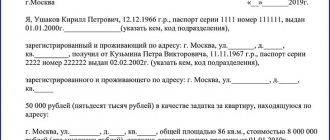The transfer of cash from one person to another must be accompanied by the preparation of a special receipt. Most often, this document is used in relations between individuals, but sometimes it can also be used between ordinary citizens and organizations (for example, when it comes to banks or microfinance companies).
- Form and sample
- Free download
- Online viewing
- Expert tested
FILES
Why do you need a receipt?
A receipt is a document that confirms that money was transferred from one individual or legal entity to another person as a loan or for other reasons.
The receipt contains information about how much money was given, under what conditions, and in what period it should be returned to the lender.
In cases where disagreements arise between the creditor and the debtor and one of them decides to go to court, it is the receipt that becomes the official document that proves the fact of the transfer of money, and also shows the conditions for their use and the time frame within which they should have been received given back.
A receipt is not one of the mandatory documents that must accompany the transfer of cash (by the way, in relations between citizens there are no such documents at all), but it is recommended.
Typical mistakes and consequences
The most common mistake when drawing up a receipt is the lack of detailed information about the parties to the transaction. Particularly high demands in this matter are placed on information about the borrower. Its volume must ensure clear and unambiguous identification of the debtor.
Another typical mistake is the absence of mandatory details of the agreement in the document. These include: the date of transfer and return of money, the loan amount, and when collecting interest - the rates for using borrowed funds. In both cases, the lack of information makes a positive court decision and, as a result, successful enforcement of the debt problematic.
When is the document most often used?
There are many reasons for creating a receipt for receiving funds:
- purchase and sale of goods;
- payment for services or rent;
- simple debt, etc.
It should be noted that in a situation where we are talking about a debt obligation, the parties sometimes enter into a loan agreement between themselves - it is more serious from the point of view of the law, because contains more complete and detailed information, but must be drawn up according to a certain scheme and structure, while a receipt is simpler in terms of design and at the same time has almost equal legal force (provided, of course, that it contains some mandatory information).
Regulatory regulation of receipts for receipt of funds
In accordance with paragraph 2 of Art. 808 of the Civil Code of the Russian Federation, a receipt confirms the loan agreement and its terms. This document can be drawn up as a supplement to the above agreement or be an independent element of the transaction.
The law does not provide for a clear form for drawing up a mortgage. No federal regulation regulates the contents of the receipt. Therefore, the parties to the transaction have the right to rely on their own beliefs.
It is not necessary to notarize the receipt. However, clause 1 of Article 163 of the Civil Code of the Russian Federation provides participants in a financial transaction with the opportunity to certify a document, thereby confirming the legality of the transfer and receipt of funds.
Important: a notary has the right to certify a receipt only if it is an attachment to the loan agreement.
Do I need to get it certified by a notary?
The obligation to certify a receipt by a notary is not stipulated in the legislation of the Russian Federation, i.e. Each lender has the right to decide for himself whether he is interested in having the receipt certified by the signature of an employee of a notary office or not.
However, the very fact of having a notary’s autograph gives the receipt greater significance, so you should not neglect it.
The only minus here, or rather, even two – time costs and additional financial expenses.
Deadline for collection of funds according to receipt
A general limitation period of three years applies to loan repayments. How to calculate it?
If the receipt indicates the loan repayment period, the statute of limitations begins to run the next day after the expiration of the repayment period. If the period is not specified, then the statute of limitations is counted after 30 days from the date of sending the lender’s request to repay the loan.
But the court will apply the statute of limitations only if the defendant declares so. Therefore, if you are the defendant, claim the statute of limitations before the court makes a decision.
Why are witnesses needed?
Some lenders prudently enlist the support of witnesses when transferring money. They may be uninterested persons, information about whom is also required to be included in the receipt (their full name, passport details and address of residence).
With their signatures, they confirm the fact that the money was transferred exactly in the amount stated in the receipt and on the conditions indicated in it.
In fact, in some way the witnesses perform the function of a notary.
Errors when drawing up a document
Making a receipt for receiving funds is quite simple. Many citizens use ready-made document samples. However, not all samples provided on the Internet exactly correspond to the legal requirements for drawing up a loan agreement. Most of the participants in the transaction make mistakes, which in the future may cause the borrower to fail to repay the debt.
Errors that affect the legitimacy of a document include:
- Inaccurate or incomplete data of the parties to the transaction.
- The loan amount is not written in block letters.
- There is no exact deadline for repayment of borrowed funds.
- Presence of blots and errors in personal data.
Unfortunately, the legal side of issuing a receipt is only the tip of the iceberg. Few people pay attention to the ethical and moral side of the process of fulfilling the terms of the contract.
Transferring the loan amount to the bank account of a relative of the lender is the most common mistake of the borrower. The text of the receipt should always indicate the bank details to which transfers will be made to repay the debt (only relevant in case of non-cash payments). If the lender asks the borrower to transfer money to an account that is not related to previous agreements, you should not comply with his requests - in most cases this is fraud.
Lenders unwittingly make a mistake that casts doubt on the fact of further debt collection from the borrower in court. Paragraph 1 of Article 807 of the Civil Code of the Russian Federation states that the loan agreement is considered concluded from the moment the money is transferred. This means that if, during a non-cash transfer of funds, the lender does not indicate the purpose of payment, the loan agreement may be considered not concluded.
You should not take the borrower’s word for it; always check his passport details, because they are his personal identifier.
Rules for drawing up receipts
This document is formed in simple written form in any form on a regular sheet of paper. It is also possible to print the receipt on a computer, but this option is not considered the best, since if there is a need for a graphological or handwriting examination, such a receipt will not be the most convenient object of study.
The text must indicate:
- date and place of document formation;
- last name, first name and patronymic of the person who takes the money, his passport details, address of residence (official and actual). Similarly, the receipt contains information about who gives the money;
- amount - it must be indicated in numbers and words;
- if cash is transferred in foreign currency, we advise you to indicate its current exchange rate and the amount in which the debt will need to be repaid;
- deadline for refund;
- return method: cash or by bank transfer - to a card or bank account) and return method - lump sum or in installments. If the second option is chosen, you need to draw up a detailed payment schedule;
- in the case where money was given, what is called “at interest,” this must also be indicated in the document (and the amount of the interest rate must be specified).
Finally, the receipt must be certified by the signature of the person who accepts the money (it is desirable that the signature matches the one in his passport) and the autographs of witnesses, if any, during the money transfer procedure. If desired, the lender can also sign the document.
The receipt is drawn up in a single copy and handed over to the lender.
FAQ
Is it worth making a receipt when granting a loan?
Yes, the presence of a document secures the creditor’s rights to close the debt.
In what form is the document drawn up - handwritten or printed?
Both options are considered legal. The main thing is to include all the necessary data and details in the document.
How to avoid mistakes when drawing up a receipt?
The easiest way is to carefully read the information posted on our website. Here are also links to the form and a sample of a completed receipt, studying which will also help you draw up the document correctly.
What to do if the borrower is bankrupt
If the borrower is declared bankrupt, the loan is collected in accordance with bankruptcy law.
After the introduction of debt restructuring, the deadline for the fulfillment of all obligations is considered to have arrived, and the accrual of penalties stops.
To be able to collect the debt, the borrower must submit an application to the arbitration court to include his claims in the register of creditors' claims within two months from the date of publication of the application declaring the debtor bankrupt (in the Kommersant newspaper). You can also track the information on the Fedresurs website.
To correctly draw up an application and prove the existence of a debt, contact a lawyer.
We have prepared a detailed article on how to recover money by initiating bankruptcy proceedings for the debtor. Useful material for lenders - we recommend you read it!
Are you a creditor and do you need protection of your interests in court? Sign up for a consultation!
Sign up
How much does certification cost?
The form of a debt agreement is arbitrary. Its notarization is not required.
If, through the operation, a person wants to receive a 100% guarantee of productive cooperation with the borrower, then the price of giving legal force to the paper will depend on these factors:
- the subject contacts a public or private lawyer;
- what region the person lives in (prices may differ in different areas and regions);
- what object of the contract are we talking about;
- how quickly the client's request needs to be fulfilled.
To find out the approximate prices of the service, there is a free consultation with a lawyer, which will help you obtain complete, reliable information about the points of interest to a person.
How to collect a debt on a receipt in court
The statement of claim is filed with the district court at the defendant’s place of residence.
If the loan amount together with interest does not exceed 50,000 rubles, then contact the magistrate.
After the court decision comes into force (one month after the decision is made, unless an appeal is filed), you can receive a writ of execution to present it to the bailiff service.
Magistrates also have jurisdiction over cases of issuing a court order. A court order is issued for monetary claims of no more than 500,000 rubles, based on a written transaction. A court order is an executive document. But not all courts recognize the receipt as an indisputable requirement.
If the amount of the claim is no more than 100,000 rubles, then the case can be considered through simplified proceedings without calling the parties.
To correctly determine the jurisdiction of the dispute and draw up a statement, contact a lawyer.
How to properly file a claim for debt collection using a receipt
When filing both a claim and an application for a court order, you must pay a state fee. Its size depends on the amount of the claim.
In the statement of claim, please indicate:
- name of the court,
- information about the plaintiff and defendant,
- circumstances of the loan,
- demand for loan repayment.
Attention! If the loan amount is indicated in the receipt in a foreign currency (currency of the debt), then you have the right to collect it only in Russian rubles (currency of payment) in an amount equivalent to the currency of the debt at the exchange rate of the Central Bank of the Russian Federation on the date of execution of the court decision. (Resolution of the Plenum of the Armed Forces of the Russian Federation No. 54 of November 22, 2016).
- requirement to pay interest for using a loan (if the loan is interest-bearing), interest on the basis of Art. 395 of the Civil Code of the Russian Federation for late loan repayment,
Attention! The obligation to pay interest on the loan amount (penalty) in the amount provided for in clause 1 of Art. 395 of the Civil Code from the day when it should have been returned until the day it is returned to the lender, arises in case of delay in obligations, regardless of the payment of interest provided for in paragraph 1 of Art. 809 of the Civil Code, for the use of a loan (Definition of the Armed Forces of the Russian Federation dated September 5, 2016 No. 4-KG15-75).
- signature.
What documents should be attached to the claim?
Attach to the application a copy of the receipt, a receipt for payment of the state fee (request for deferment), as well as evidence of sending the claim to the defendant.
In addition, evidence of the issuance of the loan and its terms may include:
- audio or video recording,
- recording of a telephone conversation.
Submit your application to the court by mail or via the Internet by filling out a special form on the website.
claim for debt collection
2021 sample
View document
Pre-trial procedure for debt collection by receipt
The lender may try to recover funds from the borrower out of court. To do this, draw up and send a claim to the debtor.
In your complaint please indicate:
- information about the parties to the loan agreement,
- the fact that the borrower has received funds,
- the loan repayment deadline has arrived,
- demand for its return.
Send the claim by mail with notification or hand it to the debtor in person.
If the loan repayment period is not specified, then before going to court you must send the borrower a written request to repay the loan, wait 30 days, and only after that go to court.
Legal advice
In relations with banking and other institutions, documentary evidence is required. The receipt is a legally effective agreement between the parties, which is important if you are not going to sign the contract, considering this procedure to be more complicated. The practice of positive cooperation should be accompanied by drawing up a receipt so that controversial issues do not arise that even the court will not quickly neutralize.
To correctly compile the document, you need to familiarize yourself with its approximate sample. Write everything in detail by hand and approve it with a signature. The accuracy of your passport data needs to be double-checked so that additional nuances do not arise later.
Video on the topic:









